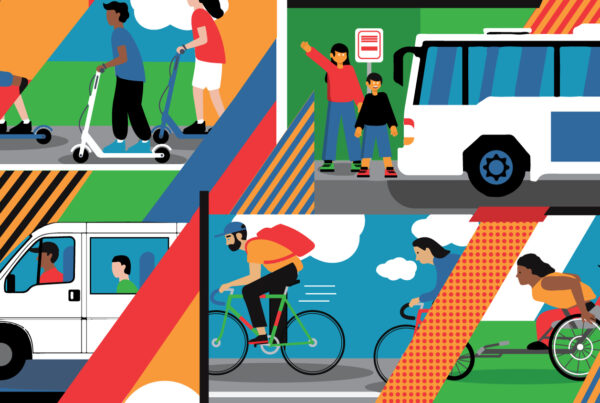It’s no secret that bikesharing, carsharing, ride-hailing and other forms of shared transportation are doing well in dense urban neighborhoods, where auto ownership rates are low and incomes are relatively high. While these core areas have been instrumental to the growth of the shared mobility industry, it is important to recognize that other markets may also have the necessary qualities to support shared mobility services.
A while back, the Shared-Use Mobility Center did a deep-dive into shared mobility opportunity as part of an extensive project for the Urban Sustainability Directors Network (USDN). You can find a full copy of the report here.
To help local leaders and stakeholders better understand transportation access in their communities and identify new opportunities, SUMC used its Opportunity Analysis and Mapping Tool, which draws from data at a Census block group level to identify potential demand for shared-use resources. The tool is part of SUMC’s comprehensive Shared Mobility Toolkit – which also includes an extensive policy database and benefits calculator.
While each community has its own unique opportunities and challenges, an analysis comparing opportunity across a range of cities revealed several overall trends worth noting, including:
- Moderately dense neighborhoods may hold the most opportunity for cities looking to reduce car ownership
Dense urban downtowns often have the lowest car ownership rates, while car ownership remains a necessity in many outlying communities where other options are lacking. Moderately dense neighborhoods, however, tend to be relatively car dependent but can also support robust transit and shared mobility systems, making them a “sweet spot” for planners looking to shift people away from private vehicles to alternative transportation modes by scaling up shared mobility.
That is especially true of moderate-density neighborhoods adjacent to a city’s downtown or transit hubs. In some cases, these communities can have a more suburban feel, with single family homes and lower density retail and employment centers. All shared modes can be integrated into these communities, but some strategic planning and implementation of supportive policies must occur for them to fully succeed.
- Many regions could easily expand city shared mobility systems to inner-ring suburbs
Often located just across the street from the city proper, inner-ring suburbs share many of the attributes of traditional urban neighborhoods, including relatively high levels of density, well-connected street grids, and frequent transit service. These qualities make them a natural fit for bikeshare and carshare systems that are expanding outward from the city’s core.
Many of these communities also have their own vibrant downtowns, which hold a mix of uses and are typically bordered by lower-density swaths of single-family homes. When modeled, these neighborhoods indicate that they could support all shared modes, but would require some additional planning to strengthen or rebuild their orientation to transit. Despite their physical attributes, many inner-ring suburbs declined economically after World War II as residents moved to more far-flung suburban communities, so the introduction of new shared-use modes—which can help cut household transportation costs and improve access to opportunity—may be especially beneficial.
- Shared mobility could help spur economic development in small city downtowns
Since downtowns in many smaller cities were established before automobile use became prevalent, they often have walkable neighborhoods featuring local retailers, public facilities such as libraries and parks, and a relatively dense urban form. Some are built around a major anchor such as a university or central thoroughfare. However, due to economic changes, many small city downtowns are no longer employment centers, with residents commuting via car from their homes to office parks on the community’s periphery.
Shared mobility—especially bikeshare—may help bring residents and visitors back downtown, providing economic benefits for retailers and the region at large while addressing local congestion issues. Most of these markets can also support a full suite of shared mobility modes, which could be expanded if already present or otherwise integrated into the planning process.
- There is still untapped potential for shared mobility in urban downtowns
Dense urban areas have experienced more growth in shared mobility, from bikesharing and carsharing to ridesourcing and microtransit, than any other neighborhood type. However, SUMC’s analysis showed that some of the areas with the most opportunity to expand shared mobility—the places with the largest difference between potential and actual vehicle counts—are still the highest density neighborhoods and employment centers, often located in or adjacent to a city’s downtown. These communities, particularly the ones in proximity to core urban centers, could readily absorb increased levels of transit along with all forms of shared mobility.
- Shared mobility can help provide first/last mile connections in outlying communities
Many low-density suburban communities are located along commuter rail lines, but offer limited transit connections beyond that service. Commercial activity is often restricted to strip malls located along major arterial roads, and most residents commute to the city center or to other employment centers throughout the region. The models indicate that such neighborhoods could support shared modes, such as ridesharing or vanpooling, that provide better first/last mile connections to transit networks and employment centers. Bikeshare and carshare fleets may be particularly effective when located near high-density residential clusters within these communities, such as apartment complexes and townhome developments. However, in order for shared mobility to work in these areas, it should also be coupled with strong transit investment.
- Densely populated, low-income neighborhoods offer ideal markets for shared mobility
SUMC’s analysis found that densely populated low-income neighborhoods, often located adjacent to core downtown areas, present a tremendous opportunity for shared mobility. While they have been often passed over by the private sector, these neighborhoods have many of the key qualities—including high population density, transit access, and walkability—needed to support shared-use systems. Additionally, the opportunity to scale up shared modes in these neighborhoods is especially compelling since they stand to profit most from the benefits of shared mobility, including reduced household transportation costs and increased connectivity to jobs and opportunities outside the immediate community.
For more information on shared mobility opportunity in your city, you can access SUMC’s interactive Shared Mobility Opportunity Analysis and Mapping Tool here. To keep up on the latest trends across the shared mobility industry, be sure to sign up for our weekly newsletter, the Mobility Hub.
Photo by Derek Liang on Unsplash


